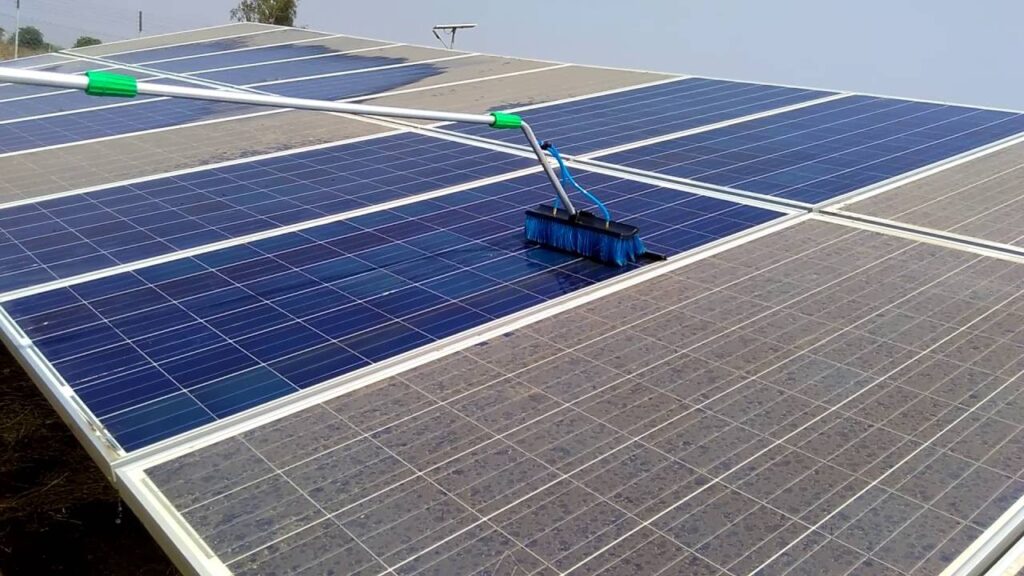The Council of Energy, Environment and Water (CEEW) estimates that water requirements from both surface water sources and groundwater sources for the operation and maintenance of solar plants in India, lie between 3-5 liters per panel and in some cases 7-8 liters per panel, where panels are usually cleaned every week.
According to a recent report from the World Resource Institute, 79% of new energy capacity is to be built in areas in India already facing water stress. This could put huge constraints on energy suppliers and will be especially difficult if we have to meet the promise set by the government to reach 100 GW of solar energy by 2022. At the moment, large scale solar PV parks are mostly located in water-scarce regions and panel cleaning tends to increase the operating costs of these plants over their lifetime.
On average, a 1 MW solar PV plant might spend more than $10,000 a year on cleaning and lose at least 3-6% of its generation due to the accumulation of dust, dirt, pollution, bird droppings, etc.
Another report, published by Bridge To India, states that almost 94% of the solar capacity in India is exposed to a medium-high level of water risk. At least 18% of the country’s installed capacity is located in arid zones in western India and 38% is located in high water-stress parts of central and southern India.
Water-Risk Exposure for Solar Power Plants in India
With the need to keep panels clean and reduce our current water usage while doing so, we have to look at alternate economically viable technologies. Companies are constantly working on this solution and many have already made good head starts:
One such company is the American Polywater Corporation that has come out with a product called the Solar Panel Wash (SPW). This is a speciality solar panel cleaner that lowers water use, as it allows for the formation of a thin continuous sheet of water on the PV panel’s protective glass sheet. The technology uses less water to wet the panel than would be required if water was used alone. It can be sprayed on the glass in both cleaning and rinsing steps of the cleaning process to further reduce water consumption. In India, 3-5 liters of water is used to clean and rinse a panel using only untreated local water. In comparison, when the SPW cleaner is used as a mixture with water, only 230 ml of water is used.
Another method that can be adopted, is to clean panels during early morning hours or after dark as cooler air minimizes thermal stress on the PV cells and the protective glass, that could otherwise damage the panels. Cold water can also micro fracture hot panels, which can evaporate the water too quickly before it has dissolved and lifted contaminants.
The recycling of wash and rinse water is another treatment method that can be used to remove impurities from the water to minimize streaking and spotting of the panel’s protective glass. Recycling can be used both to re-treat panel wash water and reduce the total amount of water used.
Ecoppia, an Israeli company, has gone one step further and eliminated the need for water. They are operating nearly 100 of their panel-cleaning robots at the Ketura Sun solar array in Israel’s Negev desert. The robots are themselves powered by solar panels and use microfiber buffers that also generate airflow to move dust off the panel surface. The robots travel across the solar panels vertically and horizontally every night for about half an hour to clean the panels. Since no water is used in this process, the company estimated that up to 420 million liters (110 million gallons) of water will be saved over 10 years. This is an economically viable solution for industrial solar plants. With an increase in the use of robots for cleaning, cheaper technology is just around the corner.
A company that follows in the footsteps of water-free panel cleaning is the Piez Clean company. Their Solar PiezoClean technology is based on Piezoelectric transparent film that is installed on top of the solar panels, and once activated, this film vibrates taking all the dust off.
These are just a few techniques currently being used to reduce water usage for solar panel cleaning. There are other new technologies such as hydrophobic and nanotechnology–based self–cleaning modules, which are currently in the test phase and will soon be rolled out into production.
As these technologies develop further, we will surely see many more innovations that will be feasible enough for individual rooftop solar installations as well, to help with their panel cleaning. Policymakers should now consider setting specifications for maximum permissible water use and introduce norms to ensure transparency in the procurement of water for solar panel cleaning.

